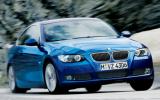What’s new?
Porsche would need to adopt a W11 cylinder configuration for the next 911 to replicate the sense of tumultuous change created by BMW’s adoption of turbocharger technology for petrol engines. That’s partly bound up in the legend of its straight sixes through linear power delivery, perpetually excellent mechanical refinement and appetite for crank speed.But it’s more to do with two decades of anti-turbo rhetoric emanating from BMW. While no one at BMW has ever stated categorically that it will never resort to the exhaust-driven blower, they’ve certainly chuckled at other manufacturers’ attempts to match the performance of its normally aspirated sixes through turbocharging.But here we are sitting in the new 335i. Running the risk of confusing the hell out of even the most ardent moniker geeks with its naming policy, BMW has decided to call this 3.0-litre twin-turbo coupé the 335i, hinting at a larger donkey out front.But for once they have a point, because the entire reason for this tangential engine development route was to create a motor that would provide the type of performance associated with a V8, but keep weight down to a minimum. But then that has always been the idea behind turbocharging.This new Three coupe is another Bangle shape incapable of doing itself justice on the page, and is therefore immeasurably sleeker in the raw. The prominent swage that defines the car’s hip line and appears to fall away rather too dramatically before the bootlid somehow doesn’t fall away too dramatically when you’re walking around the car. The rear view makes the saloon appear fussy and ugly, but then that’s not saying much. From most angles, it looks like a different model altogether.
What’s it like?
It sounds like a Focus ST when you press the starter button. Why a twin-turbo six should produce such a raspy parp from its tailpipes as the engine catches is a mystery. But at idle this is an inexpensive-sounding motor. Equally, this is possibly the only aspect of its performance that isn’t very, very impressive.With nauseating predictability, BMW has tried its hand at turbocharging and got it pretty much licked first time around. And by ‘first time around’ I am, of course, talking about the modern era and therefore ignoring the 2002 Turbo and the hilarious non-UK 745i from the mid-1980s.We’ll discuss the finer points of its installation and performance in a moment, but there is just one observation that needs to be made first: you just don’t ever know it’s turbocharged.There is a reason for this: compared with many turbocharged engines, this is a very light form of forced induction. From 2979cc it produces 302bhp at 5800rpm, which sounds impressive until you realise that the new 330i manages 272bhp without an octopus hanging off its exhaust manifold. No, BMW clearly identified everything from the turbocharging handbook that was anathema to its engineering values, and has developed this motor accordingly. Response and low emissions vetoed crazy outputs, and the results are more interesting than bluntly impressive.Using two small turbines - one each for three cylinders - and piezo direct injectors placed between the valves for extremely accurate fuel delivery and therefore perfectly judged mixture and vaporisation, BMW has managed to pull off the required confidence trick.Select fourth gear at 800rpm, open the throttle wide and it just pulls. No hesitation, nothing to indicate the presence of a turbocharger, just a small step in power at around 4000rpm, which is a variable valve phase and nothing to do with the turbo.This is a very fast car. With 295lb ft of torque from 1300rpm all the way through to 5000rpm, it will chomp through dawdling traffic. And, in the BMW tradition, it still likes to rev to around 6500rpm if required, although it becomes a touch breathless over the last 200rpm.None of this would be worthwhile if the claimed 70kg weight saving over an equivalent V8 failed to help the chassis shine.Mostly, it does. There are only two reservations: the test car was running optional 18-inch rubber and the ride was unnecessarily harsh, and I can’t give you an accurate assessment of the car’s steering because ours was fitted with BMW’s infernal active rack. It is lifeless, arcade game stuff that doesn’t belong on a car whose chassis is otherwise so well developed.











Join the debate
Add your comment
I've got one, it's fantastic except for the fragile 19" alloys.
I've got a 335i Convertible and it's fantastic except for the fragile 19" alloys.
335i engine is superb. Starting up outside the car it sounds great. Single exhaust only until it warms a small bit, 30 seconds or so, and then the other exhaust opens and the noise changes again.
The first time I heard it start up I knew I wanted it.
Auto gearbox is unnoticable, the right gear is just there. Paddles I hardly ever use, more of a gimmick on the road. The auto is superb, not like grandad lazy autos of 5-10 years ago.
Design: I think it looks great. There isn't another convertible for this sort of money I'd rather have. I'm writing this in 2012 (wish the articles had dates) and I think the older shaped 5 series was very handsome, the new one looks a bit bland.
Rear lights are gorgeous. It's lovely walking towards the back of this car at night, pressing the unlock button on the key, and seeing the rear lights light up as a flat blade of light.
6 series is similar money secondhand but it has a soft top. And the 6 series has less rear seat space, how?
If the 3 series has the hard roof and more rear seat space then what is the 6 series for?
BMW - fix the alloys. 30mm of hard sidewall run flats is hard on poor quality alloy. You've been on BBC's Watchdog over this. Please fix it soon.